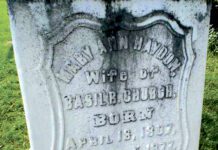The plan to bring in settlers to farm the lands around the Rideau, and so provide a barrier to any future American invasion, ran into trouble very quickly. A deep division had developed within Upper Canada which led to serious opposition to the settlement project. Lieutenant Governor Francis Gore has been in England since 1811, unable to get back to Upper Canada once war had erupted. He did not return to the province until September 1815. In the meantime, responsibility for implementing the settlement project had fallen to Sir Gordon Drummond, who had been appointed Commander-in-Chief in April, 1815. The land settlement was to be administered by the Military Settling Department, a military body, while the actual survey of lands and issuing of patents would fall to the Crown Lands Department of the Surveyor General, part of the administration headed by Gore.
Drummond was completely committed to the military need for the project. He had been Commander in Upper Canada during the war, and understood the urgent need both for the new communication route, and the settlers needed to protect the route in case of future conflicts. For him, the settlement project was a priority and a compact settlement along the proposed Rideau route was the main aim of the entire enterprise.
Gore, on the other hand, related far more to the “natural” people of Upper Canada: the United Loyalists. These original settlers had great pride in their identity, in the letters “U.E.” after their names, and they had always looked with suspicion on the influx of American immigrants before 1812. The war itself had reinforced their idea that they alone were the real loyalists, the ones with a natural right to rule and to see their ideology and culture dominate in a British colony. Gore completely identified with this view and this led him to look with great distaste on the plans to import so many new settlers.
He had two main objections. The first was that Drummond was demanding the use of the Crown Reserves in the eastern townships. These comprised one-seventh of the lots in each Township, set aside to be rented or sold for the benefit of the Crown. Gore and his Government wanted these to be granted instead to the numerous Loyalists who had yet to receive their full allocation of lands. He refused to hand them over to the Military Settling Department. His second objection to the new influx of settlers was based on the fact that giving them free land would somehow devalue the land grants of the Loyalists. The latter would no longer have the special status they so valued, that acknowledged their sacrifices and losses to the Americans because of the loyalty to the Crown.
This disagreement between Gore and Drummond went on throughout much of 1815 and 1816 and led to serious delays in locating new arrivals. A report in 1815 had shown that there was not enough land in the older townships to allow for the compact settlement originally envisaged for the scheme. Ultimately, the Lieutenant Governor solved the problem by ordering a new range of townships to be surveyed on the north side of the Rideau in March, 1816. Later on, when it became clear that much of the land in these new townships was very poor indeed, Gore decided to name them after Drummond and some of Gore’s opponents in the British Governments: Bathurst, Beckwith and Goulbourn.
Opposition to Drummond came from another unexpected source: the new arrivals themselves. A group of Scottish emigrants petitioned Gore not to send them to the Rideau, preferring instead the balmier climate of the Bay of Quinte. Their reasoning was:
The crops on the Rideau are subject to hurt from early frosts – the lands are badly watered for cattle – at an immense distance from the St. Lawrence and no water conveyance for their wood and produce…the advantages of the Upper Country [include] a great superiority of soil and climate, a much longer season for carrying on farming operations, and many other similar advantages appear of incalculable advantage to them.
They also raised an issue which went to the heart of the situation. It was hoped in Government circles that the success of these emigrants in Upper Canada would lead to others back home following them out, based on the good reports which would be sent home in letters. The Scottish petitioners basically blackmailed Gore that they would not send such glowing reports back if they were forced to settle on the Rideau:
….how galling then would it be for them not to attain their object, now when so near it and how much disappointed would their friends and acquaintances be at home, who only wait for a favourable report from the Petitioners before coming out to bless them here with their friendship and Society.
The overall result of the opposition of Gore, settlers and Loyalists generally to the scheme meant that the majority of the newcomers would settle north of the Rideau, and only a limited number in Leeds & Grenville.







